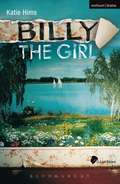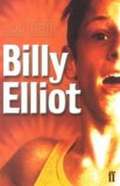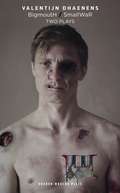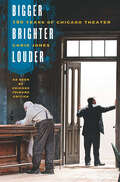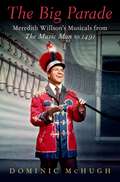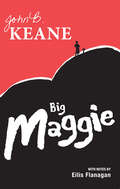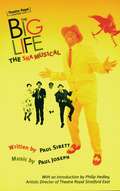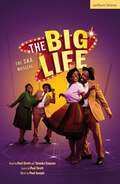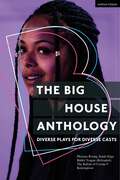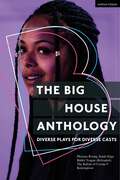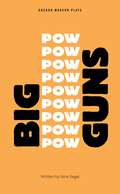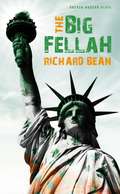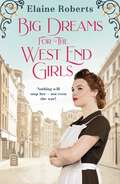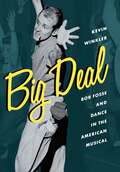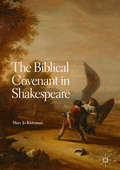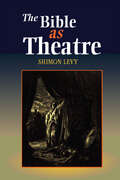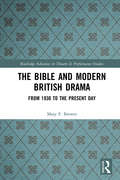- Table View
- List View
Billy the Girl (Modern Plays)
by Katie HimsI wish you could just like consider – consider the chance of it being an accident. 'Cos you're so sure. You're so sure that I did this awful thing. Billy is out waiting for love where she last saw it. Her mum is certain love has walked into her life again. Her sister thinks love could still be found somewhere in the house . . . but Billy herself isn't even allowed through the door. In Katie Hims's sweet, stark family elegy, love never dies, but sometimes – like Billy – it has to sleep in the caravan with Frank's ashes and a bear costume. Billy the Girl is a sharp, yet gentle, look at a fractured family dealing with a lifetime of mistrust.
Billy Elliot: Screenplay (PDF)
by Lee HallThe screenplay to the heart-warming hit film about a miner's son who dreams of being a ballet dancer, written by acclaimed playwright Lee Hall.
Billy Elliot: Screenplay (PDF)
by Lee HallThe screenplay to the heart-warming hit film about a miner's son who dreams of being a ballet dancer, written by acclaimed playwright Lee Hall.
BigmoutH / SmallWaR: Two Plays (Oberon Modern Plays)
by Valentijn DhaenensBigmoutH He who picks his words well can turn the weakest argument into the strongest. Valentijn Dhaenens pays tribute to 2,500 years of oration. Ingeniously weaving together fragments of seminal sermons, declarations of war, farewells, final arguments, victory speeches and eulogies from the Grand Inquisitor and Socrates to Mohammed Ali and Osama Bin Laden, BigmoutH shows that the tricks of rhetoric have hardly changed. SmallWaR When clean souls boil up in the backwash, they will consolidate after the final war, into a peace that shall endure… but not till then. By examining the things cast up in the backwash, we can gauge the progress of humanity. Ellen Newbold-La-Motte, nurse in a field hospital, behind the front lines in 1914 A nurse maintains watchful vigil over patients as fragments of past wars lurk within the shadows. SmallWaR tells the story in the words of those who were there and led the way, and – crucially – those who followed.
Bigger, Brighter, Louder: 150 Years of Chicago Theater as Seen by "Chicago Tribune" Critics
by Chris JonesThe first known Chicago Tribune theater review appeared on March 25, 1853. An anonymous notice, it shared the page with two other announcements—one about a pair of thousand-pound hogs set to be slaughtered and another trumpeting the largest load of lumber ever to leave Chicago. “And thus Chicago’s priorities were starkly laid out right there on that page,” begins Chris Jones in the introduction to this eyewitness cultural history. “Hog butcher for the world and windy self-promoter, specializing in commerce-driven superlatives. The arts came a poor third. Critics, and the artists they covered, would rail against that perceived set of civic priorities for years.” The Chicago of today, on the other hand, is regarded as one of the world’s premier cities for theater, and no one has had a more consistent front-row seat to its ascendance than the Chicago Tribune theater critics. Bigger, Brighter, Louder weaves together more than 150 years of Tribune reviews into a compelling narrative, pairing full reviews with commentary and history. With a sharp eye for telling details and a keen sense of historical context, Jones, longtime chief Tribune theater critic, takes readers through decades of highs and lows, successes and failures. The book showcases fascinating early reviews of actors and shows that would go on to achieve phenomenal success, including a tryout of A Raisin in the Sun with newcomer Sidney Poitier and the first major review of The Producers. It also delves into the rare and the unusual, such as a previously unpublished Tennessee Williams interview and a long conversation with Edward Albee’s mother. With reviews from Claudia Cassidy, Peregine Pickle, William Leonard, and more, many never collected before, Bigger, Brighter, Louder offers a unique lasting record of an ephemeral art and a riveting look at the history behind Chicago’s rise to theatrical greatness.
Bigger, Brighter, Louder: 150 Years of Chicago Theater as Seen by "Chicago Tribune" Critics
by Chris JonesThe first known Chicago Tribune theater review appeared on March 25, 1853. An anonymous notice, it shared the page with two other announcements—one about a pair of thousand-pound hogs set to be slaughtered and another trumpeting the largest load of lumber ever to leave Chicago. “And thus Chicago’s priorities were starkly laid out right there on that page,” begins Chris Jones in the introduction to this eyewitness cultural history. “Hog butcher for the world and windy self-promoter, specializing in commerce-driven superlatives. The arts came a poor third. Critics, and the artists they covered, would rail against that perceived set of civic priorities for years.” The Chicago of today, on the other hand, is regarded as one of the world’s premier cities for theater, and no one has had a more consistent front-row seat to its ascendance than the Chicago Tribune theater critics. Bigger, Brighter, Louder weaves together more than 150 years of Tribune reviews into a compelling narrative, pairing full reviews with commentary and history. With a sharp eye for telling details and a keen sense of historical context, Jones, longtime chief Tribune theater critic, takes readers through decades of highs and lows, successes and failures. The book showcases fascinating early reviews of actors and shows that would go on to achieve phenomenal success, including a tryout of A Raisin in the Sun with newcomer Sidney Poitier and the first major review of The Producers. It also delves into the rare and the unusual, such as a previously unpublished Tennessee Williams interview and a long conversation with Edward Albee’s mother. With reviews from Claudia Cassidy, Peregine Pickle, William Leonard, and more, many never collected before, Bigger, Brighter, Louder offers a unique lasting record of an ephemeral art and a riveting look at the history behind Chicago’s rise to theatrical greatness.
The Big Parade: Meredith Willson's Musicals from The Music Man to 1491 (Broadway Legacies)
by Dominic McHughIn the 1950s, Meredith Willson's The Music Man became the third longest running musical after My Fair Lady and The Sound of Music: a considerable achievement in a decade that saw the premieres of other popular works by Rodgers and Hammerstein and Lerner and Loewe, not to mention Frank Loesser's Guys and Dolls and Bernstein and Sondheim's West Side Story. The Music Man remains a popular choice for productions and has been parodied or quoted on television shows ranging from Family Guy to Grace and Frankie. Though Willson is best remembered for The Music Man, there is a great deal more to his career as a composer and lyricist. In The Big Parade, author Dominic McHugh uses newly uncovered letters, manuscripts, and production files to reveal Willson's unusual combination of experiences in his pre-Broadway career that led him to compose The Music Man at the age of 55. McHugh also gives an in depth look at the reception of The Music Man and examines the strengths and weaknesses of Willson's other three musicals, with his sustained commitment to innovation and novelty. The Big Parade is packed with new revelations about the processes involved in writing these works, as well as the trials and tribulations of working in the commercial theatre.
The Big Parade: Meredith Willson's Musicals from The Music Man to 1491 (Broadway Legacies)
by Dominic McHughIn the 1950s, Meredith Willson's The Music Man became the third longest running musical after My Fair Lady and The Sound of Music: a considerable achievement in a decade that saw the premieres of other popular works by Rodgers and Hammerstein and Lerner and Loewe, not to mention Frank Loesser's Guys and Dolls and Bernstein and Sondheim's West Side Story. The Music Man remains a popular choice for productions and has been parodied or quoted on television shows ranging from Family Guy to Grace and Frankie. Though Willson is best remembered for The Music Man, there is a great deal more to his career as a composer and lyricist. In The Big Parade, author Dominic McHugh uses newly uncovered letters, manuscripts, and production files to reveal Willson's unusual combination of experiences in his pre-Broadway career that led him to compose The Music Man at the age of 55. McHugh also gives an in depth look at the reception of The Music Man and examines the strengths and weaknesses of Willson's other three musicals, with his sustained commitment to innovation and novelty. The Big Parade is packed with new revelations about the processes involved in writing these works, as well as the trials and tribulations of working in the commercial theatre.
Big Maggie: Schools edition with notes by Eilis Flanagan
by Mr John B. Keane'Big Maggie 'J. B. Keane's most outspoken play' - The Irish Press 'Keane ... has brought the tyranny, the desperation and the frustration of the rural Irish matriarch roaring into the top twenties' 'A full-blooded, salty, earthy play with a great ring of truth and uproarious with comedy' - The Irish Times 'His depth of perception reveals a mature Keane' - Cork Examiner The story of Big Maggie Polpin and her attempts to keep her family together after the death of her husband is an enduring theatre favourite. The dialogue crackles with hilarious, caustic putdowns as the indomitable Maggie deals with her feckless family and unwanted suitors. Everyone wants a part of Big Maggie and her property, but she has other ideas. John B. Keane's wonderful creation of a rural Irish matriarch ranks with Juno, Mommo and Molly Bloom as one of the great female creations of twentieth-century Irish literature.
The Big Life: The Ska Musical (Oberon Modern Plays)
by Paul Joseph Paul Sirett Philip HedleyThink about it. Think what you could achieve without women in your life. If all the time you spent on them, you spent on yourself. Think how much money you could save. Think how much aggravation you could avoid.Journeying over from the West Indies to England, Ferdy, Lennie, Dennis and Bernie are all eager to make successes of themselves and take full advantage of what they think The Big Life has to offer. So they pledge to abstain from women for three years. But Mary, Kathy, Zuleika and Sybil have other ideas. They know that man cannot live by bread alone! Will the men stick with their idea of The Big Life, or will Cupid have the final say?The Big Life is a musical, a wonderfully upbeat story of unrequited love, and a great comedy all rolled into one. It was produced at the Theatre Royal Stratford East, April 2004.
The Big Life: The Ska Musical (Modern Plays)
by Paul Sirett Tameka EmpsonEROS!! Do your thing!It's 1950s London, and Ferdy, Bernie, Dennis and Lennie arrive from the West Indies full of expectations and aspirations.Eager to make successes of themselves, they are optimistic about what the future holds. Building this new life will take focus and sacrifice, and the young men make the bold decision to forswear wine and women for three whole years and devote themselves to their future in London. However, Sybil, Mary, Zulieka and Kathy have other ideas and the men's resolve is put to the test as the reality of life in a less-than-welcoming England makes forgoing the warmth of female company hard to resist. Will the men stick with their idea of the Big Life, or will Eros have the final say? A joyful and uplifting journey, where the story of Shakespeare's Love's Labour's Lost meets that of the Windrush generation in a fun-packed Ska musical. The Big Life returns to the stage twenty years after its Stratford East premiere and subsequent West End transfer.This edition was published to coincide with the February 2024 production at London's Stratford East, presented in association with Chuchu Nwagu Productions Ltd.
The Big Life: The Ska Musical (Modern Plays)
by Paul Sirett Tameka EmpsonEROS!! Do your thing!It's 1950s London, and Ferdy, Bernie, Dennis and Lennie arrive from the West Indies full of expectations and aspirations.Eager to make successes of themselves, they are optimistic about what the future holds. Building this new life will take focus and sacrifice, and the young men make the bold decision to forswear wine and women for three whole years and devote themselves to their future in London. However, Sybil, Mary, Zulieka and Kathy have other ideas and the men's resolve is put to the test as the reality of life in a less-than-welcoming England makes forgoing the warmth of female company hard to resist. Will the men stick with their idea of the Big Life, or will Eros have the final say? A joyful and uplifting journey, where the story of Shakespeare's Love's Labour's Lost meets that of the Windrush generation in a fun-packed Ska musical. The Big Life returns to the stage twenty years after its Stratford East premiere and subsequent West End transfer.This edition was published to coincide with the February 2024 production at London's Stratford East, presented in association with Chuchu Nwagu Productions Ltd.
The Big House Anthology: Phoenix Rising; Knife Edge; Bullet Tongue (Reloaded); The Ballad of Corona V; Redemption
by David Watson Andy Day James MeteyardThe Big House Anthology is a celebration of the last decade of work and plays by a unique theatre company, featuring five original plays that offer a chance for stories with diverse casts to contribute to the canon of theatre's literature.As a UK-based theatre company, The Big House empowers care leavers and other disadvantaged young people through performance and long-term support. Their plays are born from the hearts and minds of the young people they engage, with this anthology offering five very different plays: a runner struck down by MS; a rapper who spits and snarls and tries to find it in herself to forgive; a teenager who fights for wealth, status and respect in the underworld of county lines; a cackling cowboy they call Corona; and a dog that has been tracked, murdered and stuck in a stew. This anthology celebrates the explosive creativity that comes from mobilising and platforming diverse voices, and its importance in generating social change. Framed and introduced by directors and writers discussing their practice, along with an introduction by Jez Butterworth, this is a book for students, educators, artists, theatre-practitioners, social workers and storytellers to tell stories that are rarely told, let alone with such fierce authenticity.
The Big House Anthology: Phoenix Rising; Knife Edge; Bullet Tongue (Reloaded); The Ballad of Corona V; Redemption
by David Watson Andy Day James MeteyardThe Big House Anthology is a celebration of the last decade of work and plays by a unique theatre company, featuring five original plays that offer a chance for stories with diverse casts to contribute to the canon of theatre's literature.As a UK-based theatre company, The Big House empowers care leavers and other disadvantaged young people through performance and long-term support. Their plays are born from the hearts and minds of the young people they engage, with this anthology offering five very different plays: a runner struck down by MS; a rapper who spits and snarls and tries to find it in herself to forgive; a teenager who fights for wealth, status and respect in the underworld of county lines; a cackling cowboy they call Corona; and a dog that has been tracked, murdered and stuck in a stew. This anthology celebrates the explosive creativity that comes from mobilising and platforming diverse voices, and its importance in generating social change. Framed and introduced by directors and writers discussing their practice, along with an introduction by Jez Butterworth, this is a book for students, educators, artists, theatre-practitioners, social workers and storytellers to tell stories that are rarely told, let alone with such fierce authenticity.
Big Guns (Oberon Modern Plays)
by Nina SegalA PLAY ABOUT VIOLENCE, A SOCIETY LIVING IN FEAR AND THE MOMENT JUST - BEFORE At this point, at this exact moment, a man enters the stage. A man enters the stage and the man has a gun.. BIG GUNS is the prickling at the back of your neck, the faint taste of blood on your teeth, the could-be sounds of a strange figure in the semi-darkness. The YouTube clip you hope doesn’t load but can’t help watching. Privacy. Pornography. Flat-pack furniture. BIG GUNS is violence. Against others. Against ourselves. It’s paranoia. It’s a society living in fear. It’s the moment just – before. BIG GUNS is an unsettling new play written by Nina Segal.
The Big Fellah (Oberon Modern Plays)
by Richard BeanShortlisted for the Writers' Guild of Great Britain Best Theatre Play 2011Young New Yorker Michael Doyle decides to live up to his Irish heritage by joining the IRA. He’s recruited by Costello, the charismatic ‘Big Fellah’, who wants to use Doyle’s brownstone apartment in The Bronx as a safe house for an escaped killer. But it soon becomes clear that someone is leaking information to the FBI... Set among Irish Americans in New York, Richard Bean’s dark, glinting, funny play spans three turbulent decades. A boisterous and witty story of loyalty, disillusionment and betrayal.‘This is the funniest play about Irish troublemakers since Bill Morrison’s ‘Flying Blind’... The West End surely beckons.’- Michael Coveney, What's On Theatre‘Bean’s play is very funny, full of sharp contrasts between grim hilarity and gut-wrenching reversals.’ - The Stage‘One moment you’re exploding with mirth at its sly abrasive wit, the next its choking the laughter out of your throat. Directed with thrilling energy and searing precision by Max Stafford-Clark’ CRITICS CHOICE 4 STARS- Time Out
Big Dreams for the West End Girls (The West End Girls #2)
by Elaine RobertsNothing will stop her – not even the war!1914. Working in a bustling café on London's Shaftesbury Avenue, Joyce Taylor dreams of opening her own restaurant. But when the man she loves enlists in the war, and a surprise request comes through from her dying grandmother, Joyce's life gets turned upside down.Struggling to keep the café afloat with her new-found responsibilities, it's not long before Joyce starts to feel the pressure might be all too much. Luckily, her supportive friends Annie and Rose are on hand to help. Despite all the madness, can Joyce find a way to make her dreams come true? And will her love story have a happy ending?Annie, Rose and Joyce are three girls with very different dreams – but the same great friendship. From the author of the Foyles Bookshop series, Big Dreams for the West End Girls is a charming and uplifting WW1 saga, perfect for fans of Daisy Styles and Rosie Hendry.What readers are saying about Big Dreams for the West End Girls:'Exceptional reading! You will need tissues' 5 stars'Truly inspiring historical fiction. A lovely written piece of work! Readers will not be disappointed with this one! I loved every minute. My heart is with all of the characters' 5 stars'A heartwarming, historical novel with strong characters and lots of plot turns and twists''I highly recommend this book for its fascinating historical details and strong main character''An excellent WWI-era historical fiction saga that I really, truly enjoyed' 5 stars'One does not have to read the previous book to easily follow along and pick up the gem that is this novel' 5 stars'Well Elaine you have done it again! The first book was brilliant and this has just got better. I still feel like I am one of the girls! I can't wait to read the next in the series' 5 stars
Big Deal: Bob Fosse and Dance in the American Musical (Broadway Legacies)
by Kevin WinklerBob Fosse (1927-1987) is recognized as one of the most significant figures in post-World War II American musical theater. With his first Broadway musical, The Pajama Game in 1954, the "Fosse style" was already fully developed, with its trademark hunched shoulders, turned-in stance, and stuttering, staccato jazz movements. Fosse moved decisively into the role of director with Redhead in 1959 and was a key figure in the rise of the director-choreographer in the Broadway musical. He also became the only star director of musicals of his era--a group that included Jerome Robbins, Gower Champion, Michael Kidd, and Harold Prince--to equal his Broadway success in films. Following his unprecedented triple crown of show business awards in 1973 (an Oscar for Cabaret, Emmy for Liza with a Z, and Tony for Pippin), Fosse assumed complete control of virtually every element of his projects. But when at last he had achieved complete autonomy, his final efforts, the film Star 80 and the musical Big Deal, written and directed by Fosse, were rejected by audiences and critics. A fascinating look at the evolution of Fosse as choreographer and director, Big Deal: Bob Fosse and Dance in the American Musical considers Fosse's career in the context of changes in the Broadway musical theater over four decades. It traces his early dance years and the importance of mentors George Abbott and Jerome Robbins on his work. It examines how each of the important women in his adult life--all dancers--impacted his career and influenced his dance aesthetic. Finally, the book investigates how his evolution as both artist and individual mirrored the social and political climate of his era and allowed him to comfortably ride a wave of cultural changes.
Big Deal: Bob Fosse and Dance in the American Musical (Broadway Legacies)
by Kevin WinklerBob Fosse (1927-1987) is recognized as one of the most significant figures in post-World War II American musical theater. With his first Broadway musical, The Pajama Game in 1954, the "Fosse style" was already fully developed, with its trademark hunched shoulders, turned-in stance, and stuttering, staccato jazz movements. Fosse moved decisively into the role of director with Redhead in 1959 and was a key figure in the rise of the director-choreographer in the Broadway musical. He also became the only star director of musicals of his era--a group that included Jerome Robbins, Gower Champion, Michael Kidd, and Harold Prince--to equal his Broadway success in films. Following his unprecedented triple crown of show business awards in 1973 (an Oscar for Cabaret, Emmy for Liza with a Z, and Tony for Pippin), Fosse assumed complete control of virtually every element of his projects. But when at last he had achieved complete autonomy, his final efforts, the film Star 80 and the musical Big Deal, written and directed by Fosse, were rejected by audiences and critics. A fascinating look at the evolution of Fosse as choreographer and director, Big Deal: Bob Fosse and Dance in the American Musical considers Fosse's career in the context of changes in the Broadway musical theater over four decades. It traces his early dance years and the importance of mentors George Abbott and Jerome Robbins on his work. It examines how each of the important women in his adult life--all dancers--impacted his career and influenced his dance aesthetic. Finally, the book investigates how his evolution as both artist and individual mirrored the social and political climate of his era and allowed him to comfortably ride a wave of cultural changes.
The Biblical Covenant in Shakespeare
by Mary Jo KietzmanThe theo-political idea of covenant—a sacred binding agreement—formalizes relationships and inaugurates politics in the Hebrew Bible, and it was the most significant revolutionary idea to come out of the Protestant Reformation. Central to sixteenth-century theology, covenant became the cornerstone of the seventeenth-century English Commonweath, evidenced by Parliament’s passage of the Protestation Oath in 1641 which was the “first national covenant against popery and arbitrary government,” followed by the Solemn League and Covenant in 1643. Although there are plenty of books on Shakespeare and religion and Shakespeare and the Bible, no recent critics have recognized how Shakespeare’s plays popularized and spread the covenant idea, making it available for the modern project. By seeding the plays with allusions to biblical covenant stories, Shakespeare not only lends ethical weight to secular lives but develops covenant as the core idea in a civil religion or a founding myth of the early-modern political community, writ small (family and friendship) and large (business and state). Playhouse relationships, especially those between actors and audiences, were also understood through the covenant model, which lent ethical shading to the convention of direct address. Revealing covenant as the biblical beating heart of Shakespeare’s drama, this book helps to explain how the plays provide a smooth transition into secular society based on the idea of social contract.
The Biblical Covenant in Shakespeare
by Mary Jo KietzmanThe theo-political idea of covenant—a sacred binding agreement—formalizes relationships and inaugurates politics in the Hebrew Bible, and it was the most significant revolutionary idea to come out of the Protestant Reformation. Central to sixteenth-century theology, covenant became the cornerstone of the seventeenth-century English Commonweath, evidenced by Parliament’s passage of the Protestation Oath in 1641 which was the “first national covenant against popery and arbitrary government,” followed by the Solemn League and Covenant in 1643. Although there are plenty of books on Shakespeare and religion and Shakespeare and the Bible, no recent critics have recognized how Shakespeare’s plays popularized and spread the covenant idea, making it available for the modern project. By seeding the plays with allusions to biblical covenant stories, Shakespeare not only lends ethical weight to secular lives but develops covenant as the core idea in a civil religion or a founding myth of the early-modern political community, writ small (family and friendship) and large (business and state). Playhouse relationships, especially those between actors and audiences, were also understood through the covenant model, which lent ethical shading to the convention of direct address. Revealing covenant as the biblical beating heart of Shakespeare’s drama, this book helps to explain how the plays provide a smooth transition into secular society based on the idea of social contract.
The Bible as Theatre
by Shimon LevyA reading of the narrative portions of the Old Testament as dramatic texts.
The Bible as Theatre
by Shimon LevyA reading of the narrative portions of the Old Testament as dramatic texts.
The Bible and Modern British Drama: From 1930 to the Present Day (Routledge Advances in Theatre & Performance Studies)
by Mary F. BrewerThe Bible and Modern British Drama: 1930 to the Present Day is the first full-length study to explore how playwrights in the modern period have adapted popular biblical stories, such as Abraham and Isaac, Moses and the Exodus from Egypt, and the life and death of Jesus, for the stage. The book offers detailed and accessible interpretations of the work of well-known dramatists such as Christopher Fry, Howard Brenton, and Steven Berkoff, alongside the work of writers whose plays have been neglected in recent criticism, such as James Bridie and Laurence Housman. The drama is analysed within the context of changes in religious belief and practice over the course of the modern period in Britain, comparing plays that approach the Bible from a traditional religious perspective with those that offer alternative viewpoints on the text, including the voices of gay, feminist, black, Jewish, and Muslim dramatists. In doing so, the author offers a broad and in-depth exploration that is grounded in current scholarship, ranging from the past to present, across boundaries of race and gender. Ideal for students, researchers, and general readers interested in understanding how the Bible has served as an important source text for British playwrights in the twentieth and twenty-first centuries, The Bible and Modern British Drama shows how Bible-based drama has been influential in creating and disseminating ideas of what constitutes a "good" life, both on an individual and social level.
